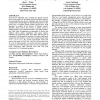Free Online Productivity Tools
i2Speak
i2Symbol
i2OCR
iTex2Img
iWeb2Print
iWeb2Shot
i2Type
iPdf2Split
iPdf2Merge
i2Bopomofo
i2Arabic
i2Style
i2Image
i2PDF
iLatex2Rtf
Sci2ools
BIRTHDAY
2009
Springer
2009
Springer
Vertical Object Layout and Compression for Fixed Heaps
Research into embedded sensor networks has placed increased focus on the problem of developing reliable and flexible software for microcontroller-class devices. Languages such as nesC [8] and Virgil [14] have brought higher-level programming idioms to this lowest layer of software, thereby adding expressiveness. Both languages are marked by the absence of dynamic memory allocation, which removes the need for a runtime system to manage memory. To provide data structures, nesC offers modules, and Virgil offers the application an opportunity to allocate and initialize objects during compilation. This paper explores techniques for compressing fixed object heaps with the goal of reducing the RAM footprint of a program. We explore table-based compression and introduce a novel form of object layout called vertical object layout. We provide experimental results that measure the impact on RAM size, code size, and execution time for a set of Virgil programs. Our results show that compressed ver...
| Added | 19 May 2010 |
| Updated | 19 May 2010 |
| Type | Conference |
| Year | 2009 |
| Where | BIRTHDAY |
| Authors | Ben Titzer, Jens Palsberg |
Comments (0)

